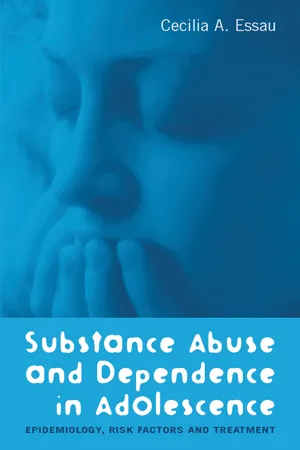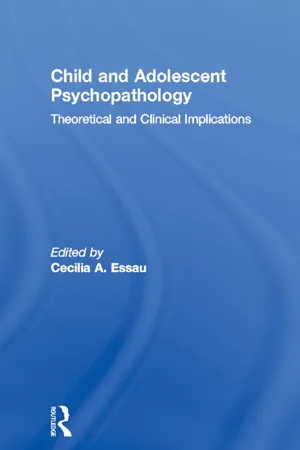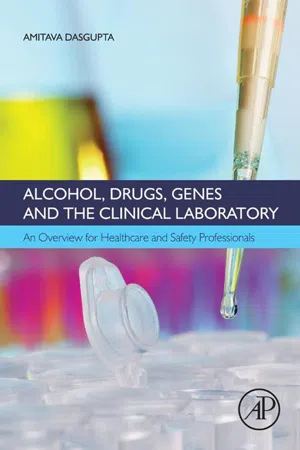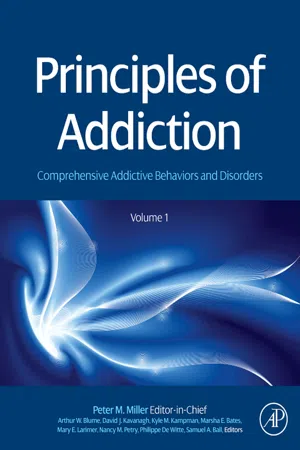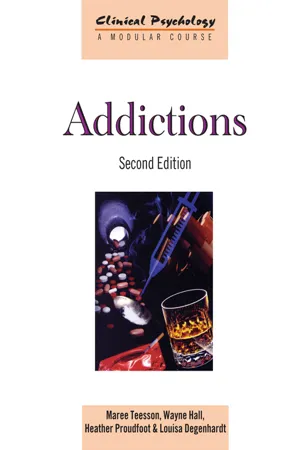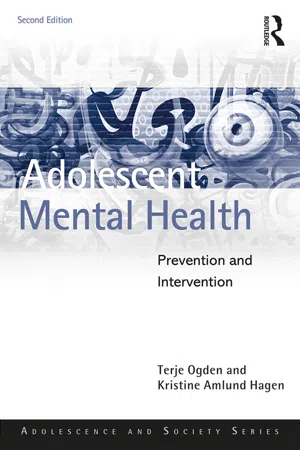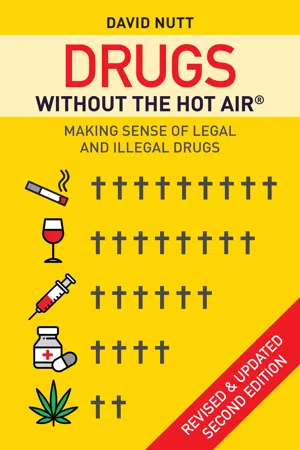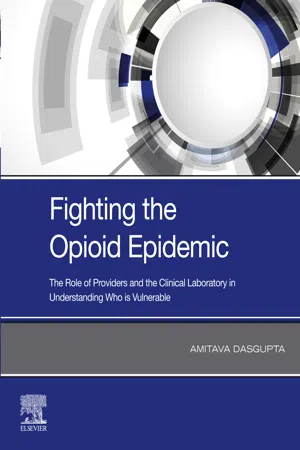Psychology
Risk Factors for Addiction
Risk factors for addiction include genetic predisposition, environmental influences, mental health disorders, and early exposure to substances. Genetic factors can increase susceptibility to addiction, while environmental influences such as peer pressure and trauma can also contribute. Mental health disorders like depression and anxiety can heighten the risk, and early exposure to substances can impact brain development, increasing vulnerability to addiction.
Written by Perlego with AI-assistance
Related key terms
10 Key excerpts on "Risk Factors for Addiction"
- eBook - ePub
Substance Abuse and Dependence in Adolescence
Epidemiology, Risk Factors and Treatment
- Cecilia A. Essau(Author)
- 2014(Publication Date)
- Routledge(Publisher)
Risk factorsTerri N. Sullivan and Albert D. FarrellSubstance abuse and dependence are characterized by detrimental patterns of use that result in adverse personal consequences (e.g., repeated interpersonal problems, physical harm) and symptoms such as tolerance and withdrawal reflecting psychological and/or physiological dependence, respectively (American Psychiatric Association, 1994). Both patterns of misuse are subsumed under the category of substance use disorders. The diagnosis of these disorders typically does not occur until late adolescence or early adulthood, but risk factors for substance use disorders are identifiable in childhood and early adolescence (Chassin and Ritter, 2001). Identification of risk factors is important for several reasons. Because risk factors increase the probability of developing substance use disorders, interventions focused on decreasing exposure to risk factors or buffering their impact should be helpful in preventing this outcome. Identification of risk factors across childhood and adolescence can inform developers of prevention programmes about relevant developmental timeframes for intervention, and guide the selection of optimum approaches for prevention and intervention (e.g., school, family, or community-based approaches). Finally, risk factor indices can be used at the individual level to identify high-risk youth and families for appropriate services (Farrell et al ., 1992).The risk factor approach stems from epidemiological roots where the primary focus is to understand which individuals develop a particular disease and what factors contribute to its emergence (Feuerstein et al ., 1986). Clayton defined a risk factor as “an individual attribute, individual characteristic, situational condition, or environmental context that increases the probability of drug use or abuse or a transition in level of involvement with drugs” (1992, p. 15). Clayton also described general principles regarding risk factors. An individual risk factor is defined as a dichotomous variable that is either present or absent. For instance, the risk factor “peer pressure to use drugs” was considered to be present for middle school students who reported feeling pressure from their friends to drink or use drugs at least once in the past 30 days (Farrell et al - eBook - ePub
On Human Nature
Biology, Psychology, Ethics, Politics, and Religion
- Michel Tibayrenc, Francisco J. Ayala(Authors)
- 2016(Publication Date)
- Academic Press(Publisher)
Aghaii et al., 2012 ) integrating the results of different studies to investigate the impact of environmental versus social factors in people's tendency to become addicted found a greater relationship between environmental factors than other social factors, indicating that at least between those two, environment seems to be more important than societal variables in promoting drug use and abuse. However, emerging evidence supports an important role for societal factors.Environment
In an attempt to better understand the contribution of the aforementioned environmental variables, the field of clinical and preclinical addiction research has proposed that the environment can affect addictive behaviors in three ways: adverse life experiences (ie, stress), enhanced drug-associated learning, and the environment associated to drug taking. At a clinical level, in general, due to the intrinsic difficulties and limitations of controlling many of the mentioned variables, human studies have not always provided enough evidence for a relationship between environment and addiction in humans. This is particularly the case when assessing stress impact on addiction. Thus, human studies have mostly focused the attention on the individual history of adverse life experiences and drug addiction. For instance, events as different as sexual abuse/harassment, combat-stress, occupational stress, marriage dissatisfaction, and physical traumas have been linked to the abuse of psychostimulants, opioids, and alcohol, and adverse childhood experiences play an important role in the susceptibility to drug abuse (for detailed references, Caprioli et al., 2007 ). In this context, stress effects on alcohol have been a main focus of research. In general, various laboratory stressors have been examined for their effects on alcohol self-administration, and the results vary depending on the experimental stressor chosen and many other factors (reviewed in Spanagel et al., 2014a ). The effects of drug-conditioned associations (that is, Pavlovian conditioning: initially neutral environmental stimuli paired with the drug experience) have been almost exclusively studied in the context of prevention, aiming to identify the neurobiological basis of craving and relapse. In the 1980s, drug-conditioned associations were described in humans to induce withdrawal-like symptoms and craving (Childress et al., 1984 , 1986 ). In this context, the work from Volkow using imaging techniques has provided a great advance showing neurobiological changes associated to cue-induced craving (for a review see Volkow and Morales, 2015 ). Besides stress and drug-related learning, early studies pointed out that the setting where the drug is consumed importantly influences the drug experience in terms of behavioral and psychological responses (ie, Kelleher and Morse, 1968 ). Again, in this particular context, human evidences are not too much. A clear example is represented by MDMA, which is exclusively consumed in clubs (Parrott, 2004 ; Schifano, 2000 ). Two other studies were performed in the context of alcohol and amphetamine (Sher, 1985 ; Zacny et al., 1992 ). However, emerging evidence suggests that the degree of promoting drug use of some environmental settings is particularly associated with specific drugs, at least cocaine and heroin. Retrospective studies have shown that while heroin is used preferentially at home, cocaine is preferentially consumed outside the home (Caprioli et al., 2009 ; Badiani and Spagnolo, 2013 - eBook - ePub
Child and Adolescent Psychopathology
Theoretical and Clinical Implications
- Cecilia A. Essau(Author)
- 2012(Publication Date)
- Routledge(Publisher)
Thus, risk factors of substance abuse throughout adolescence and early adulthood may be derived from the adolescence substance use literature. Risk factors of substance use and abuse are comprised of variables from multiple domains, which, as suggested by Rutter (1982), are complex, multiple and interacting. Domains include genetic factors, biological factors, individual factors, and cognitive factors. Additionally, within an ecological approach (Bronfenbrenner, 1988) several domains encompass the context in which the adolescent or young adult develops, including peer factors, family factors, and neighborhood or community factors. In Table 8.2, we have listed empirically supported examples from the literature of risk factors within each of these domains. Table 8.2 Examples of risk factors associated with substance use and abuse Domains Examples of risk factors Genetic factors Through reward-deficiency pathways of addiction (Koob and LeMoal, 2001; Robinson and Berridge, 2001) Biological factors Early biological maturation, particularly for girls (Graber et al., 1997; Stice et al., 2001) Direct and indirect influences of hormonal levels including testosterone (Booth et al., 1999; Martin et al., 2001), estradiol (Inoff-Germain et al., 1988), and cortisol (Susman and Pajer, 2004) Individual factors Poor social skills (Dishion, 1990) Poor self-esteem (Connor, 1994; Kaplan et al., 1982) Stressful life events (Wills et al., 2002) Sensation seeking (Simon et al., 1995; Wills et al., 2002) Antisocial behaviour (Jessor, 1987; Severson et al., 2003) Academic underachievement (Kandel and Davies, 1992) Child temperament (Caspi et al., 1997) Cognitive factors Social images of substance users (Gibbons and Gerrard, 1997) Subjective norms regarding use (Ajzen and Fishbein, 1980) Attitude toward use (Ajzen and Fishbein, 1980) Peer factors Association with substance-using peers (Andrews et al., 2002; Patterson et al., 2000) Peer rejection (Dishion et al., - eBook - ePub
Alcohol, Drugs, Genes and the Clinical Laboratory
An Overview for Healthcare and Safety Professionals
- Amitava Dasgupta(Author)
- 2016(Publication Date)
- Academic Press(Publisher)
5Link between environmental factors, personality factors, and addiction
Abstract
Scientists have determined that certain personality traits such as novelty-seeking behavior and low harm-avoidance increase the risk of alcohol and drug abuse. On the other hand a person with a good social network has a much lower risk of alcohol dependence. It has been speculated that environmental factors are more important in making an individual susceptible to alcohol and drug abuse. Childhood neglect or abuse is a major risk factor for drug and alcohol abuse. Peer pressure experienced by teenagers contributes significantly to their first underage experiments with alcohol. The attitude of adult parents and relatives towards alcohol plays an important role in determining risk of underage drinking behavior.Keywords
Underage drinking; childhood neglect; social network; personality type and alcohol abuse; antisocial personality disorderIntroduction
Behavioral addiction is defined as an intense desire to repeat some action that is pleasurable, or perceived to improve well-being, or capable of alleviating some personal distress, despite the awareness that such an action may have negative consequences. From a psychological, neurological, and social standpoint such repeated patterns of actions which are characterized as “addictive behavior” include drug as well as alcohol addiction. In the new “Diagnostics and Statistical Manual of Mental Disorders” (DSM-5; 5th edition, published by American Psychiatric Association), gambling disorder is included in the “Substance Related and Addictive Disorder” chapter because such behavior produces similar activations in the brain as seen with alcohol or substance use disorder [1] .Clinicians used DSM-IV criteria, through a structured interview, for many years for diagnosis of psychiatric illnesses including alcohol and substance use disorders—which are themselves psychiatric illnesses. There are significant overlaps between DSM-5 and DSM-IV criteria, except DSM-IV describes two distinct disorders: alcohol abuse and alcohol dependence, with specific criteria for each disorder. However, in DSM-5, both disorders are integrated into one disorder termed as alcohol use disorder (AUD) with subclassification of mild, moderate, and severe disorder. There are 11 symptoms in DSM-5 and using this guideline, the presence of at least 2 of the 11 criteria in past 12 months in a patient indicates the patient is suffering from AUD. If only two to three criteria are present the diagnosis is mild, if four to five criteria are present then it is moderate AUD and if six or more criteria are present then the diagnosis is severe AUD. In one study using DSM-5 criteria, the prevalence of AUD was 10.8% among 34,653 surveyed participants. According to DSM-IV criteria, 9.7% in the same population would have AUD diagnosis [2] - eBook - ePub
Principles of Addiction
Comprehensive Addictive Behaviors and Disorders, Volume 1
- (Author)
- 2013(Publication Date)
- Academic Press(Publisher)
Researchers have discovered consistent predictors of drug use initiation and subsequent use across multiple substances of abuse, including personality variables, learning factors, and higher-order cognitive processes. Substance abuse is highly comorbid with affective disorders and other psychiatric diagnoses, although some psychiatric problems (e.g. depression and anxiety) may be effects of the substance use as well as causal factors. Many (but not all) substance abusers have a history of antisocial behavior, nonconformity, deviance, acting out, impulsivity, and low self-esteem; however, these also can be the effects of substance misuse. Research establishing the role of psychosocial factors in the development of addictive behaviors provides evidence that addiction is a multifactorial problem, not a disease solely caused by a measureable underlying physiological abnormality or deficit, and provides support for the biopsychosocial model of addiction.Risk Factors in Children
Much research has been conducted on childhood variables that increase the risk for alcohol dependence and substance use disorders. Consistently found in the literature is evidence for an increased likelihood of addiction among children who are victims of abuse and who exhibit externalizing behaviors such as those seen in conduct disorder, attention deficit/hyperactivity disorder, and oppositional defiance. In particular, antisocial and deviant behaviors such as aggression, hostility, vandalism, sadistic behavior, rebelliousness, and association with deviant peer groups place one at risk for substance use disorders later in life. One study found that problem drinkers exhibited more externalizing behaviors in childhood than did moderate drinkers, and moderate drinkers exhibited more of these behaviors than did light drinkers. Other research has found that tolerance of deviance in adolescence is a strong predictor of alcohol and other substance abuse in adulthood. Antisocial personality disorder is highly comorbid with substance abuse and dependence, and antisocial behaviors in childhood are strong predictors of substance problems in adulthood, independent of a family history of substance abuse. - eBook - ePub
- Maree Teesson, Wayne Hall, Heather Proudfoot, Louisa Degenhardt(Authors)
- 2013(Publication Date)
- Psychology Press(Publisher)
Key pathways in the brain are involved in substance use and dependence, and changes occur in the brain's balance and neurotransmitter function after chronic drug use. A variety of factors appear to explain why some people become dependent on drugs. Genetic factors appear to play a part in developing dependence on many of the most commonly used licit and illicit substances. Certain environmental factors also increase the likelihood of problematic substance use, such as economic disadvantage, family conflict, modelling of drug use, or parents’ permissive attitudes towards drug use, as well as conduct and emotional problems at an early age.Psychological approaches to the issue of substance dependence have attempted to explain some of the behavioural and cognitive phenomena thought to underlie problematic substance use. Some theories – such as those proposing a personality type more disposed to addiction, or those characterizing the “rational” addict – have played less of a role in clinical responses to addiction. Learning theories have played more of a role because learning plays an important role in the development and maintenance of substance use problems and learning may also be used to overcome these problems.Explanations of why some people become dependent on psychoactive substances vary in the level of explanation – biological, psychological, or sociocultural – but all have been supported by empirical research. Comprehensive theories, such as that proposed by West, are providing useful syntheses of these explanations that may assist clinicians in treating addictive disorders. - eBook - ePub
Adolescent Mental Health
Prevention and Intervention
- Terje Ogden, Kristine Amlund Hagen(Authors)
- 2018(Publication Date)
- Routledge(Publisher)
Adolescent drug abuse can be defined as the frequent use of alcohol or other drugs during the teenage years to such an extent that it leads to personal dysfunction and social problems (Hawkins, Catalano, & Miller, 1992). The most frequently used drug is alcohol. Indicators of dependence include affective symptoms, blackouts, reduced activity level, risky sexual behavior, and cravings. Compared to adults, occupational impairment, physiological dependence, and legal problems are rarer. Alcohol abuse progresses in quite predictable stages from initiation, experimental, or occasional use, to regular or escalating use and finally problem use and dependence (Chassin, Ritter, Trim, & King, 2006; Petraitis, Flay, & Miller, 1995). The prevalence figures vary considerably from one country to the next and it is a general finding that adolescent substance use seldom occurs alone (Fuller, 2008). One of the most consistent findings in the literature is that it accompanies disruptive behavior disorders (that include opposition, conduct problems, and ADHD). Several large-scale epidemiological studies of drug use and abuse in young people have been conducted in both the US and Europe, and some of the key findings are reported by Weinberg, Harper, and Brumback (2005), including:The risk factor approach• alcohol and nicotine are the most frequently used substances, followed closely by marijuana;• only about 1 in 12 who have taken drugs are heavy users;• drug use is uncommon in children under the age of 12, with the exception of inhalants;• overall drug use is about as common in girls as in boys, but alcohol abuse is more common in males;• association with social background varies according to the type of drug, but is more frequent among young people with poor academic achievement; and• among current approaches to the prevention and treatment of drug problems, those addressing risk and protective factors appear to be the most promising.A risk factor is by definition statistically associated with increased probability of unfavorable outcomes. Consequently, the goal of a risk-focused approach is to prevent drug abuse by eliminating or reducing the precursors. In other words, risk factors increase a young person’s chance of using drugs, but they are present or occur before the actual drug problems are manifested. In adolescence, association with drug-abusing peers and peer pressure are highly influential factors (Robertson, David, & Rao, 2003). When entering high school, adolescents are faced with new social, emotional, and educational challenges, and they participate in more social activities that may involve drugs and alcohol. - eBook - ePub
Drugs without the hot air
Making sense of legal and illegal drugs
- David Nutt(Author)
- 2020(Publication Date)
- UIT Cambridge(Publisher)
Chapter 9. What is addiction? Is there an “addictive personality”?
Using substances from outside the body to change our brain chemistry is something humans have always done, and the psychoactive effects created are similar to the changes we experience when we eat nice food or take exercise. For the majority of people the majority of the time, this doesn’t lead to compulsive behaviour – we remain in control, and pretty soon our brains return to their prior state. For a minority, however, drug use leads to drug abuse and addiction, just as a minority of people become addicted to food, gambling or sex. For these people, satisfying their cravings for whatever it is they’re addicted to becomes the most powerful source of motivation in their lives, overpowering every other need and often leading them to harm themselves and others.There are three elements that affect whether a person becomes addicted to a particular drug (Figure 9.1 ):Figure 9.1: The three elements that affect whether a person becomes addicted to a particular drug.1. Drug-related factors include how the drug reaches the brain, and what it does when it gets there. Tolerance and withdrawal also affect its addictiveness.2. Social factors include the availability and acceptability of using the drug, the prevalence of advertising, how the drug makes groups behave, and the economic and social costs.3. Personal and biological factors are those such as age, gender and genetics.In this chapter we look at the mechanisms of addiction, tolerance and withdrawal, and why certain people seem to have “addictive personalities”. (Chapter 4 has already examined some of the drug-related factors, which we explore in more detail in chapter 11 , and we cover the social factors in chapter 12 .)Addiction in history
Our understanding of addiction has increased as more drugs have become available, and as their role in society has changed. Until the 19th century, heavy drinking or use of other drugs wasn’t seen as a special category of behaviour, but as a sin of excess, similar to overeating – gluttony was a problem because you were eating too much , not because food itself was a bad thing. Although excessive use of drugs was seen as problematic, the majority of people usually didn’t have access to enough potent substances to have that problem. An exception was the † Gin Craze of the 18th - eBook - ePub
Fighting the Opioid Epidemic
The Role of Providers and the Clinical Laboratory in Understanding Who is Vulnerable
- Amitava Dasgupta(Author)
- 2020(Publication Date)
- Elsevier(Publisher)
Children of alcoholics are considered to be at high risk because there is a greater likelihood that they will develop alcoholism compared with a randomly selected child from the same community. Children of alcoholics and children of drug-abusing parents are especially vulnerable to the risk of maladaptive behavior because they have combinations of many risk factors present in their lives. However, the most important risk factor is their parent's substance-abusing behavior that may put children of substance abusers at biologic, psychological, and environmental risk. A series of studies measured mortality, physiology, and general health in the offspring of alcoholic parents and concluded that when mothers stopped drinking during gestation, their children were healthier. Today, research can be classified into studies of fetal alcohol syndrome, the transmission of alcoholism, psychobiologic markers of vulnerability, and psychosocial characteristics. Each of these studies hypothesizes that differences between children of alcoholics and children of nonalcoholics influence maladaptive behaviors later in life, such as academic failure or alcoholism. In contrast, relatively little is known about children of heroin addicts, cocaine abusers, or polydrug abusers. Nonetheless, many researchers suggest that the children of addicted parents are at greater risk for later dysfunctional behaviors including substance use disorder [ 51 ]. Many environmental household factors are linked with the risk of substance abuse in adolescent years. Jurich et al. concluded that nine family factors that have an impact on drug abuse include parental absence, discipline, scapegoating, hypocritical morality, parent-child communication gap, parental divorce, mother-father conflicts, family breakups, and the use of “psychological crutches” to cope with stress. A psychological crutch in parallel to a physical crutch is anything a person relies on during a vulnerable situation - eBook - ePub
Cognition and Addiction
A Researcher's Guide from Mechanisms Towards Interventions
- Antonio Verdejo García(Author)
- 2019(Publication Date)
- Academic Press(Publisher)
Fig. 14.1 .Individual risk factors for problem gambling
Personality
In the addictions literature, the relation between externalizing disorders and personality traits such as impulsivity and initiation of substance use and risk for developing substance use disorders has been well-established (see Chapter 7 in this book). Impulsivity can be defined as not only the tendency to act on impulses without sufficient thinking but also includes tendencies like a preference for immediate rewards instead of delayed rewards. It is recognized that impulsivity is not a unitary construct but consists of and is influenced by several cognitive, emotional, and neural processes (Broos et al., 2012 ; Evenden, 1999 ). Externalizing psychopathologies such as attention deficit/hyperactivity disorder (AD/HD), behavior dysregulation, and antisocial traits are risk factors for both the (early) initiation of substance use and for the development of substance use disorders (e.g., Chang et al., 2012 ; Holtmann et al., 2011 ; Kuperman et al., 2001 ). Because problem gambling has a lower prevalence compared with substance use disorders like alcohol or cannabis use disorders, specific relations between early childhood behavior and personality traits are more difficult to investigate. Despite this, a few studies indicate that a similar relation exists between early childhood behavior, which can be characterized as dysregulated, impulsive/disinhibited, or externalizing, and later development of (problematic) gambling.Based on a large longitudinal birth cohort from New Zealand (the Dunedin cohort), Slutske and colleagues reported on the prediction of “disordered gambling” at either age 21 or 32, based on temperamental behavior when the participants from this study were only 3-year-old toddlers (Slutske et al., 2012
Index pages curate the most relevant extracts from our library of academic textbooks. They’ve been created using an in-house natural language model (NLM), each adding context and meaning to key research topics.
